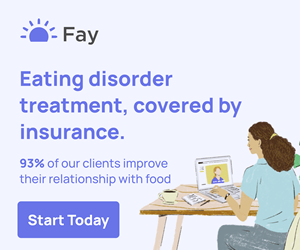- Calls to this hotline are currently being directed to Within Health, Fay or Eating Disorder Solutions
- Representatives are standing by 24/7 to help answer your questions
- All calls are confidential and HIPAA compliant
- There is no obligation or cost to call
- Eating Disorder Hope does not receive any commissions or fees dependent upon which provider you select
- Additional treatment providers are located on our directory or samhsa.gov
What is an Eating Disorder: Types, Symptoms, Risks, and Causes
Eating disorders are serious mental and physical illnesses that involve complex and damaging relationships with food, eating, exercise, and body image. These disorders impact approximately 20 million women and 10 million men in the United States and are found in all populations regardless of age, ethnicity, socioeconomic status, religion, sex, gender, etc.
Advertisement
Eating Disorder Definition from the DSM-5
The DSM-5 (Diagnostic & Statistical Manual of Mental Disorders, Fifth Edition) lists eating disorders under the category of “Feeding & Eating Disorders” and describes that they are “characterized by a persistent disturbance of eating or eating-related behavior that results in the altered consumption or absorption of food that significantly impairs physical health or psychosocial functioning [1].”
This category specifies diagnostic criteria for the disorders of “pica, rumination disorder, avoidant/restrictive food intake disorder, anorexia nervosa, bulimia nervosa, and binge-eating disorder [1].”

Eating Disorder Facts
Eating disorders are complicated and nuanced disorders and vary from person to person. However, there are some overall eating disorder facts that research has been able to clearly delineate regardless of the individual.
- Eating disorders do not discriminate and are observed in “people of all ages, racial/ethnic backgrounds, body weights, and genders [2 – NIMH].”
- Eating disorder onset typically occurs in adolescence or young adulthood but is not limited to these life stages.
- There is no one distinct cause of eating disorders. Research has found a number of “genetic, biological, behavioral, psychological, and social factors” that can increase the risk of eating disorder development [2].
- Eating disorders can be life-threatening and have the highest mortality rate of any mental illness.
- While eating disorders do not have a “miracle cure,” there are numerous evidence-based practices proven to support eating disorder recovery.
What Are the Different Types of Eating Disorders?
As mentioned above, there are many more eating disorder diagnoses than the three most commonly heard about (Anorexia Nervosa, Bulimia Nervosa, & Binge Eating Disorder). Each diagnosis has specific criteria differentiating it from other mental illnesses and eating disorders. Recognizing the distinct difference in disorders can help to improve treatment and recovery outcomes.
Anorexia Nervosa
For Anorexia Nervosa to be diagnosed, the DSM-5 specifies that the individual must engage in persistent energy intake restriction, have an intense fear of gaining weight or becoming fat, or be engaging in a persistent behavior that interferes with weight gain, and the individual has a disturbance in their own perception of their body weight or shape [1].
These individuals often present with a bodyweight that is “below a minimally normal level for age, sex, developmental trajectory, and physical health,” but this is not always the case. You cannot determine if someone struggles with anorexia based on their body appearance alone.
Bulimia Nervosa
Bulimia Nervosa is characterized by three essential features: “recurrent episodes of binge eating, recurrent inappropriate compensatory behaviors to prevent weight gain, and self-evaluation that is unduly influenced by body shape and weight [1].”
An individual must engage in these behaviors at least once per week for three months to meet the criteria for diagnosis [1].
Referring to the first feature, a binge is characterized by an individual “eating, in a discrete period of time, an amount of food that is definitely larger than what most individuals would eat in a similar period of time under similar circumstances” and that the individuals feel “a sense of lack of control over eating during the episode [1].”
Binge Eating Disorder (BED)
Binge Eating Disorder, commonly referred to as BED is the most common eating disorder diagnosis among all others. The DSM-5 specifies that BED involves binge eating episodes defined as mentioned above in the Bulimia Nervosa diagnosis.
BED differs from Bulimia Nervosa in that BED involves no recurrent use of inappropriate behaviors to compensate for binge episodes and does not occur exclusively during anorexia or bulimia episodes
BED also does not include an individual’s perception of body shape and weight in diagnostic criteria.
Pica
Pica involves an individual eating one (or more) non-nutritive, nonfood substance on a persistent basis for at least one month [1]. Pica is diagnosed when this behavior occurs, often enough to warrant clinical attention [1].
The DSM-5 specifies that the eating of non-nutritive, non-food substances must be inappropriate to the developmental level of the individual and “not part of a culturally supported or socially normative practice [1].”
Rumination Disorder
Rumination Disorder is characterized by “repeated regurgitation of food occurring after feeding or eating over a period of at least one month [1].” Those with Rumination Disorder regurgitate previously swallowed food with no apparent symptoms of nausea, involuntary retching, or disgust [1].
Diagnostic criteria of Rumination Disorder specifies that it should not be diagnosed if behaviors can be better explained by a gastrointestinal or medical condition or if they occur exclusively during an anorexia, bulimia, BED, or ARFID episode [1].
Avoidant/Restrictive Food Intake Disorder (ARFID)
Rumination Disorder is characterized by “repeated regurgitation of food occurring after feeding or eating over a period of at least one month [1].” Those with Rumination Disorder regurgitate previously swallowed food with no apparent symptoms of nausea, involuntary retching, or disgust [1].
Diagnostic criteria of Rumination Disorder specifies that it should not be diagnosed if behaviors can be better explained by a gastrointestinal or medical condition or if they occur exclusively during an anorexia, bulimia, BED, or ARFID episode [1].
Other Specified Feeding or Eating Disorder (OSFED)
This category is intended for cases wherein symptoms of a feeding or eating disorder are present and cause clinically significant distress or impairment but do not meet the full criteria for the above-specified disorders.
OSFED Disorders include:
- Atypical Anorexia Nervosa: An individual meeting all criteria for anorexia are met except the individual’s weight is within or above the normal range.
- Bulimia Nervosa (of low frequency and/or limited duration: As the individual meets, all criteria for bulimia except binge eating and compensatory behaviors occur less than once a week and/or for less than three months.
- Binge-Eating Disorder (of low frequency and/or limited duration): An individual meets all criteria for BED except binge eating episodes occur less than once/week and/or for less than three months.
- Purging Disorder: An individual engages in regular purging behavior to influence body weight or shape but does not engage in binge eating behaviors.
Unspecified Feeding or Eating Disorder
This category, as with OSFED, includes disorders that are symptomatic of an eating disorder diagnosis but do not meet the full criteria.
UFED differs from OSFED in that it is used “in situations in which the clinician chooses not to specify the reason that the criteria are not met” for a specific disorder or “there is insufficient information to make a more specific diagnosis” such as emergency room settings [1].
What about the term ‘food addiction’? Is it an addiction, an eating disorder, or, neither? It’s currently not listed in the DSM-5 and with the limited research, It is too early to determine if there is a clinical importance to the idea of food addiction [3].
Related Reading
- Weight & Body Image
- Obesity and Eating Disorders
- Orthorexia, Excessive Exercise & Nutrition
- Addictions & Eating Disorders
- Eating Disorder Statistic
- Eating Disorder Research, Studies, and Tests
- Eating Disorders in Men
- What is Too Skinny
- What to Know About BMI
- Testing for an Eating Disorder
- What Causes Eating Disorders
- Demographic Statistics for Eating Disorders

Eating Disorder Symptoms
Eating disorders manifest in varying ways as they are complicated disorders that impact psychological, physical, and sociological health. Determining whether someone is struggling with an eating disorder is not an exact science due to the many manifestations of these disorders, but, there are some symptoms that can present as warning signs.
Emotional & Behavioral ED Symptoms
Our physical bodies, psychological, functioning, cognitive wellness, and choices and behaviors are all deeply intertwined and impactful of one another. Below are a few emotional and behavioral symptoms that may indicate an individual is struggling with eating disorder beliefs or behaviors.
- Beliefs/patterns/choices that indicate a focus on weight loss, dieting, food rules, or eating patterns.
- Extreme mood swings.
- Difficulty
- Checking in the mirror often.
- Withdrawing from others, decreased socializing, especially when food is involved.
- Presenting as hyper-focused on weight, food, calories, nutritional content of food.
- Eating alone or hiding food.
- Skipping meals.
- Intense fear of gaining weight.
- Distorted body image.
- Tangential thought process and difficulty concentrating.
Physical Warning Signs of an Eating Disorder
A starved brain and body cannot function optimally. Therefore, an individual struggling with an eating disorder will present with at least some, if not all, of the physical signs of an eating disorder below:
- Weight fluctuations (both up and down) that occur rapidly.
- Severe constipation.
- Low blood pressure
- Slowed breathing and pulse.
- Lethargy, sluggishness, or consistent reports of feeling tired.
- Brittle hair and nails.
- Dry, yellowish skin.
- Loss of menstrual cycle (amenorrhea).
- Growth of soft hair all over body (lanugo).
- Stomach/gastrointestinal issues.
- Dizziness/fainting/lightheadedness.
- Muscle weakness.
- Impaired immune system functioning.
Risk Factors for Eating Disorders
It is unsurprising with all of the physical, emotional, and behavioral symptoms of eating disorders above that the long-term consequences can be severe. The malnourishment that results from disordered eating impacts all organ systems in the body including the brain as well as the cardiovascular, endocrine, and gastrointestinal systems.
Due to malnourishment, the body breaks down its own tissues, including the heart, which leads to a lack of energy to pump blood through the body, lowering pulse and blood pressure and increasing the risk of heart failure. The electrolyte imbalance caused by vomiting or laxative use or excessive water intake can also increase the risk of heart failure.
Lack of fat and cholesterol through disordered eating impacts functions of the endocrine system, such as the production of sex and thyroid hormones. For this reason, individuals may experience loss of or irregularities in the menstrual cycle. This also impacts bone density, metabolic rate, and issues regulating core body temperature (which can result in hypothermia).
It is difficult for the brain to function when it is not receiving proper and consistent nourishment. This leads to difficulty concentrating, sleeping, or staying asleep, sleep apnea, and dizziness or fainting. The electrolytes mentioned above are also used to create signals in the brain, meaning malnourishment disrupts the ability of the brain to communicate effectively to the body.
Finally, gastrointestinally, eating disorders impact stomach emptying and absorption of nutrients which can lead to severe stomach issues. Consistent vomiting can wear down the esophagus causing it to rupture, which is life-threatening. Binge eating can also cause a life-threatening emergency in that it can lead to a stomach rupture. Essentially, all of the organs and gastrointestinal functions are severely disturbed in eating disorder behaviors and can result in many life-threatening illnesses and issues.

What Causes Eating Disorders?
There are many genetic, environmental, and sociological factors that contribute to eating disorder development.
Biological Factors
Biological risk factors for eating disorders include many genetic factors such as predispositions to medical and mental illness.
Individuals that have a family history of mental illness diagnoses are more likely to experience mental illness themselves. Even if the predisposed mental illness is not an eating disorder, eating disorders commonly co-occur with diagnoses such as depression, anxiety, or substance use issues, to name a few.
An individual’s medical history can also increase eating disorder risk, as research indicates that certain illnesses, such as Type 1 Diabetes, are associated with increased risk for eating disorder development.
Environmental Factors
Environmental factors include the dynamics that surround an individual.
This can include family dynamics, as family-related beliefs and discussions around weight, food, and self-view are shown to be associated with eating disorder diagnoses.
The social views one absorbs via peers, social media, television/movies, and consumer culture are also related to the increased development of eating disorders.
Psychological Factors
Psychological factors for eating disorders include a co-occurring diagnosis of another disorder, as mentioned above.
Additionally, there are specific personality traits that research indicates can increase the likelihood of developing an eating disorder, such as perfectionism, low self-worth, distorted body image, or impulsivity.
Experiencing a past or present trauma also increases one’s likelihood of developing a disordered eating belief or pattern.
How to Treat Eating Disorders
Due to the insidious ways in which eating disorders pervade all aspects of one’s body, mind, and life, receiving the appropriate treatment is important. There are various levels of care designed to treat specific stages of eating disorder severity—these range from inpatient at a medical facility down to outpatient. Any eating disorder treatment center can assess a struggling individual to determine the appropriate level of care.
Outside of receiving treatment in general, it is also important to ensure the facility uses evidence-based practices, as these can lead to better long-term outcomes.
There are many evidence-based treatments that can support eating disorder recovery; the most well-known and most commonly used is Cognitive Behavioral Therapy (CBT), Dialectical Behavior Therapy (DBT), and Family-Based Treatment (also known as “The Maudsley Method”).
Do not be afraid to ask any questions that arise if you or a loved one are searching for the treatment that will best support recovery.
Resources
- American Psychiatric Association. (2013). Diagnostic and statistical manual of mental disorders (5th ed.)
- Unknown (2021). Eating disorders: about more than food. National Institute of Mental Health. Retrieved from https://www.nimh.nih.gov/health/publications/eating-disorders.
- Hauck C, Cook B, Ellrott T. Food addiction, eating addiction and eating disorders. Proc Nutr Soc. 2020 Feb;79(1):103-112. doi: 10.1017/S0029665119001162. Epub 2019 Nov 20. PMID: 31744566. https://pubmed.ncbi.nlm.nih.gov/31744566/
Author
Publish Date:
Last Updated:
Page Last Reviewed and Updated By: Jacquelyn Ekern, MS, LPC on June 14, 2021



